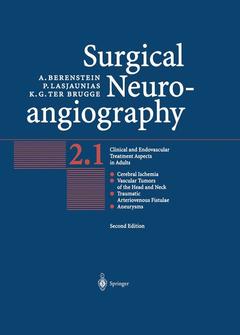Description
Surgical Neuroangiography (2nd Ed., 2nd ed. 2004)
Vol.2: Clinical and Endovascular Treatment Aspects in Adults
Authors: Berenstein Alejandro, Lasjaunias Pierre, brugge Karel G.
Language: English
Subjects for Surgical Neuroangiography:
Keywords
Stent; Tumor; cerebral; classification; dangerous vessels; diagnosis; maxillofacial; spinal cord; vascularisation
231.04 €
In Print (Delivery period: 15 days).
Add to cartPublication date: 10-2012
1287 p. · 21x27.9 cm · Paperback
295.39 €
Subject to availability at the publisher.
Add to cartPublication date: 03-2004
1287 p. · 19.3x26 cm · Hardback
Description
/li>Contents
/li>Comment
/li>
Surgical Neuroangiography: Clinical and Interventional Aspects in Adults covers a variety of protocols and strategies combining functional vascular anatomy with a complete appreciation of the various disease processes, their pathophysiology, clinical presentation, and natural history, as well as recent technological advances. The newer endovascular techniques that apply to embolization of aneurysms, vascular malformations, and tumors of the spine, spinal cord, brain, and maxillofacial areas are reviewed. Novel techniques of revascularization for occlusive vascular diseases in the brachiocephalic and cerebral vasculature are expanding and revolutionizing the field. Implementing optimally efficient and safe strategies for occlusion or revascularization of arterial or venous structures requires the knowledge of collateral circulation covered in this volume. Alejandro Berenstein, Pierre Lasjaunias, and Karel ter Brugge, pioneers in the field with over 20 years of experience, present the second volume of the second edition of Surgical Neuroangiography, combining volumes 2, 4 and 5 of the previous edition and adding a new section, "Occlusive Vascular Diseases."
Comprehensive, practice-oriented work on vascular intervention in adults and children
Written by the leading experts with many years' experience in research and teaching
Richly illustrated overview of all treatment modalities
These books may interest you

Practical Neuroangiography 286.55 €



